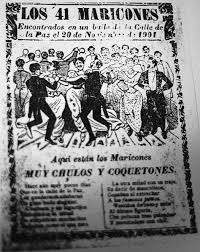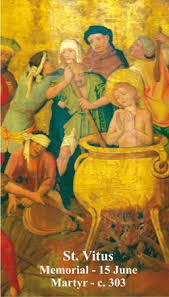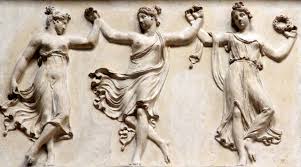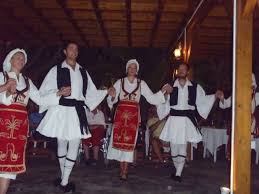The dance of the 41
Spanish: Baile de los cuarenta y uno)
 The dance of the 41 was a scandal in Mexico in 1901 whereh 41 or 42 men were arrested for homosexuality.
The dance of the 41 was a scandal in Mexico in 1901 whereh 41 or 42 men were arrested for homosexuality.
On November 18, 1901, during the reign of Porfirio Díaz, police raided a house in the Calle de la Paz in Mexico city. There was danced by a group of men of whom 19 were dressed and made-up as a woman.
They were convicted of "assault on morality and good manners', and banned (from the military, but for civilian jobs!)tTo Yucatán. The press remained remarkably discreet about it. The list of those arrested was never published, presumably because many among them came from the upper class of Porfirican society. Soon became even claimed that it were 42 men. The 42th, Ignacio de la Torre y Mier, than was the gay nephew of President Díaz, which would be acquitted by the intervention of the president.
In Mexico is the number 41 by this incident still symbol of homosexuality. It is a taboo, and is therefore often shunned. Army units have for example never the number 41, and in house numbers, number of rooms, number plates for vehicles, etc. is often beaten or replaced 41 by 40a. And no one is celebrating his 41st birthday.
(On 4 December of the same year a similar raid took place at a group of lesbians, but that received much less attention and impact.)
Patron Saint of the dance: Saint Vitus
 The Catholic Church has a sacred for all professions and ailments, just as our ancestors for everything had a god.
The Catholic Church has a sacred for all professions and ailments, just as our ancestors for everything had a god.
Patron Saint of the dancers is St. Vitus, which is celebrated on 15 June. In the Middle Ages it was considered to be the longest day of the year, the summer solstice.
In addition, St. Vitus acts also as patron of actors, acrobats, magicians and comedians. And of coppersmiths, copper and boiler blacksmiths, tinkers, brewers, bar staff and bar tenders. But also pharmacists; of lame, , deaf, dumb and blind and beggars.
And of mountain men and miners; of wine makers and grape pickers. And for married couples and families; and even pets: especially dogs and birds, such as chickens, hens and other poultry. To exit as patron of sources.
Vitus intercession is invoked at sowing and at harvest (solstice!), against thunder, lightning, fire and against infertility. But also against bedwetting, possession, epilepsy, hysteria, rabies, dog and snake bites, (morbid) long sleeping and overslept, St. Vitus Dance (chorea minor), nervous disorders, seizures, convulsions, cramps, spastic disorders, irascibility, eye diseases and hearing impairment. These phenomena are related to sudden uncontrollable muscle or nerve spasms. St. Vitus Dance came in the 13th and 14th centuries common in malnourished people. See separate article.
Celts & Roman dances
Celts
Slavs, Germans and Celts had many rituals which were danced. Often later, they were just 'charmed' in the Middle Ages, by the church and as sacred places and gods, incorporated into their religious rites.
Dancing around the maypole - in some European countries still common - for example is part of an ancient fertility rite, which was conducted by Slavic and Germanic peoples in the spring. The Celts also had hunting and animal dances.
Roman dances
 After the death of Alexander the Great in 323 BC, his empire felled apart over time. Gradually, the Romans took over many pieces and states. They found the Greek or Hellenistic culture superior and adopted much uses. Among them gods, and dancing.
After the death of Alexander the Great in 323 BC, his empire felled apart over time. Gradually, the Romans took over many pieces and states. They found the Greek or Hellenistic culture superior and adopted much uses. Among them gods, and dancing.
In ancient Rome dance was held in high esteem. The philosopher and writer Lucian saw dance as a divine gift to mankind. According to him dance was created simultaneously with the cosmos: the order in the universe according to him was a round dance of divine origin of planets and stars.
From 200 BC. The Roman movement theater developed under the influence of, among other Greek dancing. Pantomime and dramatic hand gestures were mainly used. The dancers often wore motion inhibiting robes and masks. With their feet they gave a rhythm.
Terpsichore was their muse of dance and lyric poetry.
Greek dance
The Greeks were convinced that dance was the language of the gods. Dance was for them a means to get closer to their gods. There are read vague descriptions, but they usually come from philosophers such as Homer and Aristotle. Plato wrote: "The religious dances are not just religious acts; this mysterious dances depict the character of the gods to whom they are dedicated. "
Mastering the art of dance was considered a sign of education and civilization.
 Images on vases and frescoes give a further idea of what was possible danced. Around 550 BC the Greeks ruled southern Spain. In Greek art are also dancers with arm feature and postures similar to that of Spanish dancers of today. They also show castanets like instruments and hand clapping to accompany the dance.
Images on vases and frescoes give a further idea of what was possible danced. Around 550 BC the Greeks ruled southern Spain. In Greek art are also dancers with arm feature and postures similar to that of Spanish dancers of today. They also show castanets like instruments and hand clapping to accompany the dance.
Characteristic of Greek dancing is to limit the movements of the pelvis.
In Greek mythology, the dance occurs in Rea, wife of Kronos, who had dethroned his father Uranus. Because Kronos feared that his children would also expel him, he ate all his newborns. When Rea gave birth to the last child, Zeus, she wrapped a stone in swaddling clothes and gave this package to Kronos. Who ate it without suspicion. Rea hid Zeus in a cave on the island of Crete. The child was fed with honey and goat's milk. She asked Kourites to perform war dances of the cave so that Kronos would not hear the cries of the baby. When Zeus later dethroned Kronos , Kourites became the priest of the new world. His followers went on with the originated dance as part of a religious ceremony.
The oldest data come from the Minoan civilization on Crete from 3000- 1400 BC. Music, singing and dancing heard together in entertainment and in religious ceremonies. Crete was occupied around 1,500 BC by Greece and much uses were included to the home contry.
Dance was part of theater, both in tragedy and comedy.
In a tragedy actors story the deeds of kings, from myths and legends of gods and demigods. This was interspersed with singing and dancing of the choir. Fifteen men in three rows behind each other commented on the story with songs and dramatic gestures in solemn dances. These differing dances were called emmeleia.
Emmeleia also represents a performed by women in honor of the gods reverent, solemn dancing around the altar or a procession to a temple.
In the comedies events in Greek politics and celebrities were taken in the sights with games, dancing and singing. Later also funny and absurd scenes from everyday life. Popular in comedy was the kordax, which was challenging shaken with abdomen and buttocks, while the feet remained standing next to each other.
A typical movement was hitting its own buttocks with the heels. Contemporary writers disapproved this dance (obviously).
Battle Dancings were military training in concentration, agility, speed and power. The best known is the pyrriche performed by nine armed dancers to worship the Phrygian goddess Cybele. It is a weapon dance in which guys since the age of five practiced their martial skills in both Athens and Sparta.
Also popular was the Gymnopedie, a dance in which naked young men struggled with each other. Later it became more of a theater dance with an emphasis on beauty and spectacular moves. Women also brought him up as main dance of the Lacedaemonians that were celebrated annually on the market square of Sparta.
The Geranos depicts the story of Theseus, who after killing the Minotaur in the Labyrinth of Knossos, stopped at Delos to sacrifice to the goddess Aphrodite and thereby danced around an altar.
The Ierakio was a woman dance at festivals around the goddess Hera.
The Epilinios was an ecstatic dance where the harvested grapes were crushed by foot.
The satirical Sikkinis dance was danced by Satyrs who thereby imitated the movement of cats.
The Imeneos was a quick wedding dance with many turns, danced by the bride with her mother and friends.
In Hormos a young man leads a row of dancers with skilled movements. A young woman mimics those as an example of decency and respect for all other female dancers.
Iporchima is a combination of pantomime and music, danced in Crete by boys and girls who meanwhile sang poems. From this about 300 different Balkan Dances were made.
There were several annual religious festivals. The most prestigious (from the sixth century BC.) was the spring festival in honor of Dionysos.
The dithyramb was an ardent hymn to Dionysos. Performed by a large group of men or boys while dancing in a circle. The dance leader portrayed in the middle with dramatic gestures of life, death and resurrection of Dionysos.
Not all dances were subdued and respectful. Wild rituals were performed in honor of Dionysus, the god of wine and ecstasy. The maenads - into frenzy 'fallen women' - went singing and dancing into the mountains. These bloodthirsty savages stomped, swirled and jumped for days until they were in a trance. They were at the height of their delirium apparently even bloodthirsty and teared animals. Later did men disguised as satyrs participate in this worship, and they became orgies.
Dionysus was called by the Romans Bacchus.
The Greeks hadas the goddess of dance 'Terpsichore' who was also muse of dance with the Romans.
Dancing in Antiquity
One of the oldest words regarding dance is Mousiké. It was for dance, music and poetry which in ancient times formed a unity .
Just as music was played long before it was written (or even later, registered and recorded) was dancing too long practiced before dances were listed or described. We do not know how long humans or humanoids already are dancing.
On rock carvings are figures showed of which we can assume that they dance. They are thousands, sometimes more than 30,000 years old. A remarkable dancer is the in animal skins dressed Shaman or Le danseur des Trois Frères ("Dancing Sorcerer") from Montesquieu-Avantès (Fr), approximately 13,000 BC
Since there is no text or clear visual material from the prehistoric everyone has the right to make up a story for himself. Concerned dance it is often compared to the situation at contemporary primitive peoples. But also at the features dance still has with us today. It provides inspiration for the creation of dance, and the different types of dance we can distinguish, which can be found in almost all cultures.
 They danced to beg for favors of gods. This also includes a successful hunt, or fertility. Through repetition and tradition arose fixed patterns and rituals. These religious dances took probably place in a circle from India to Gaul. Later around a (sacred) tree or place of sacrifice, and at a temple.
They danced to beg for favors of gods. This also includes a successful hunt, or fertility. Through repetition and tradition arose fixed patterns and rituals. These religious dances took probably place in a circle from India to Gaul. Later around a (sacred) tree or place of sacrifice, and at a temple.
A special variant is the ecstatic dance, with dancers, faithful believers or priests (-ess) dancing until they get outside themselves. Perhaps some found in headbanging and dancing dervish.
Hunting dances had also possible narrative and / or educational function. This siding has probably led to theater dance, and theater in general.
Another track developed into armed, combat or war dance. Not only useful to whip up warriors, but also to intimidate the opponents (see also Haka). The Romans and Greeks even had military dances that were purely physical training, with fast turns, defensive and offensive movements. Martial Arts was later sometimes camouflaged as a dance. (See Capoeira.)
From thanking the gods for a successful hunt or harvest, it is a small step to dance as a social event. A harvest celebration, a celebration, relaxation, togetherness, marriage, fun, maypole, death ...
And beg the gods for fertility and healthy living descendants is just a (dance) pass away from temptation dancing or mating behavior. We even also find this in many other species (See viper dance, dancing animals, mosquitoes dance, mating dance ...) The attention is then usually of story and purpose to beautiful women and movements. Also, research on contemporary dance shows that we can derive (subconscious) from their dance moves the vitality of potential partners and their suitability for reproduction .
So not much new under the sun.
Another constant throughout the history of the dance is that the religious and / or political elite was always ready to condemn dance, contempt and prohibit it. By elevating themselves above the people they looked down on what they called vulgar. Especially dances where people touched each other they found obscene. (e.g Argentine tango, waltz, bachata). When they finally took the movements the men initially used gloves, or a handkerchief to touch the lady (waltz). The round spin or rotate (Viennese waltz), and moving with hips and pelvis (merengue, salsa ..) were originally detested by the elite.
For later, as always, eager to be adopted. Possibly after a little scraping and civilizing (e.g. ballroom tango).
Until the 6th century church dances were still normal and customary. Later "the work of the Devil" then was a sin. (See also Dance of Death). After 1204 only a procession with dance steps was allowed.
With the Renaissance (around 1450) dancing became popular again. The first written dance was registrated by Louis Pecourt at the court of Louis XVI in 1670.
